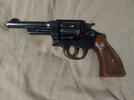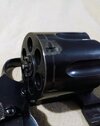I use gourmet toothpics (much stronger than regular ones) to clean out the recesses on my 22lr revolvers. The carbon build-up is hard enough to require the stronger pick.I was competing in IPSC when S&W brought out the M686 and stopped pinning their barrels. At one match, a competitor who was a local law enforcement officer told us a story about the fixed sight L frame revolvers his Department had been issued. The non pinned barrel unscrewed on his. LEO decided to play a joke on his unit armorer. He told the unit armorer that he had cleaned his revolver and could not get it back together again. He pulled the cylinder and crane from a paper bag and put that on the table, then the frame, and then lastly the barrel! Need we say the armorer had a strong reaction?
Well something was wrong with that pistol as the barrel did unscrew. While I would prefer a pinned barrel, they are not coming back.
As for recessed cylinders, they probably made sense when shooters were using balloon head cartridges. I have some vintage 45LC balloon head, and I pulled several case heads off in the sizing die. It took hardly any effort, and it was very time consuming knocking the case body out of the die. Those balloon head cases might have been appropriate for black powder, but I bet the weak heads were a continuing problem with smokeless. I believe with modern solid head cartridges, the case head has sufficient support without the recesses. And it is easy to look at the side of the cylinder to see if there are cartridges in there. Popping the cylinder open to examine for loaded rounds takes two hands.
I always find recessed cylinders a pain to clean. Cleaning those shallow recesses of debris is time consuming and I need a pointy thing for the rim holes.

murf



